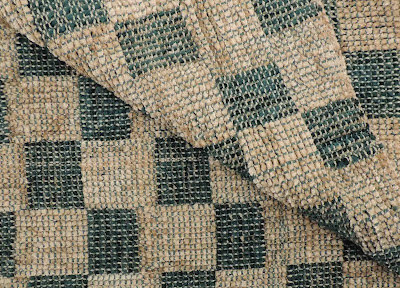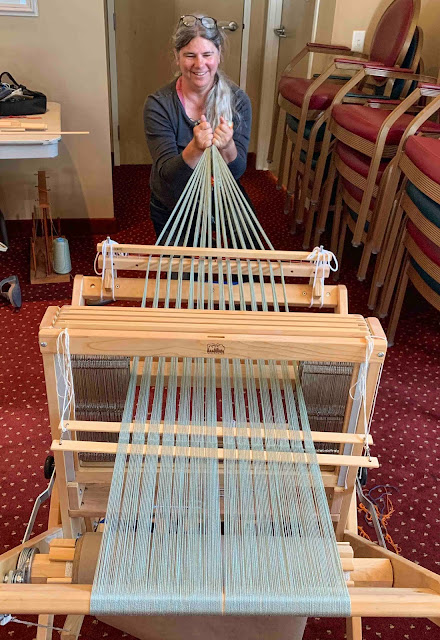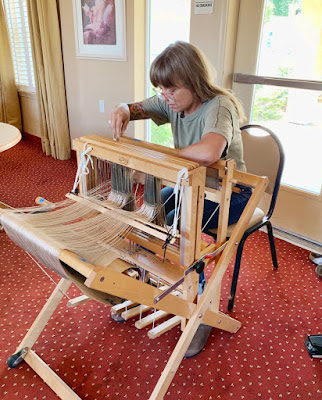Sage Weavers meetings continue throughout the summer months when the guild has a bit of a break in June, July and August. Vacations leave our meetings a bit sparse sometimes, but it is still fun to connect when and where we can.
In July and August we had members back from CNCH and MAFA. And, some had just been busy at their looms, so we had lots to talk about and lots of projects to enjoy. Because many of you did have vacation plans and weren't able to join us this summer, here are a few highlights.
Diane S. brought in a luxurious scarf woven with 60/2 silk in two different painted skeins. She said that the colors were of a very similar value, therefore worked well with each other. Diane's draft used a parallel threading with a nonrepeating treadling sequence. Sett is 60 epi, and beat at about 56 epi. The design is striking, the hand is wonderful and Diane showed off her trademark double weave selvedge. She thought you might want to try a double weave selvedge on your next piece? Here is a link.
https://callybooker.co.uk/2017/10/comparing-selvedges/ (Note that you will need four shafts dedicated to the selvedge treatment).
Rae brought in a couple of towels woven using three shafts (see our previous posts from our last year's 3 shaft study group). This towel was woven with the light side up - but Rae found that she like the side with the bright stripes better. What do you think? This towel was woven with 5/2 cotton and sett at 16 epi.
Sue M. had been to a Rosalie Neilsen class on Rep Weave. She wasn't pleased with her first attempts, so she put on another warp and wove this stunning table runner. She said it wasn't an easy weave because the warp was so dense that all the shafts tended to rise every time she tried to open a shed. Slow weaving - but a stunning piece. The warp was 3/2 cottons sett at 48 epi.
Lorene S. has been experimenting with thick and thin structure. She did a couple of infinity scarves, but brought in the ends of the warps to show us what she has been weaving. They both feature chenille as the thick thread in both warp and weft. The circle pattern was featured in Handwoven Nov/Dec 2016. This same magazine has a lot of information about thick and thin and Diversified Plain Weave which is the guild's structure study for this next year. Circles are rare in woven design and these are really special.


Anni B. needed to beef up her stash of baby blankets - just in case! She found Tom Knisely's article in the May/June 2019 issue of Handwoven and wove several blankets on the same warp. Anni says she rarely follows the pattern or directions without changing something, but this time she did. Both of the pieces shown here were woven on a straight draw threading. The amazing part of the undulating design is that the floats are tied down with a tabby pick between each pattern pick. The other design is a waffle weave and can be used as a nice thirsty towel for baby.
Kathy R. has been following along with weaving lessons from the
Jane Stafford's Online Guild. She was intrigued with a recent project that used linen in the warp and silk in the weft. Kathy used some 40/2 linen that had belonged to her grandmother who was also a weaver. The linen gives some body to the scarf, but the silk really changes the character of the piece. The scarf is very supple and its drape is amazing. In order to get the shear sections next to the firmly woven sections, you need to cram some threads closely in the reed and spread others out in a loose sett. The weaving is done pretty much in the same way by lightly beating several picks and then carefully beating wefts with greater force for the closely woven sections. A great technique that is well worth learning.

Kathy also belongs to the thick and thin study group. At a previous Sage Weavers' meeting we discussed the fact that Summer and Winter can be woven with thinner tabby picks and a heavier pattern weft. Kathy wove two textured silk scarves in Summer and Winter using this technique. Another way to get an undulating pattern without the floats!
Every Sage Weavers has handwoven pieces that amaze. If you are interested in weaving and live in the Reno area, please check our blog calendar and join us when we meet.












































